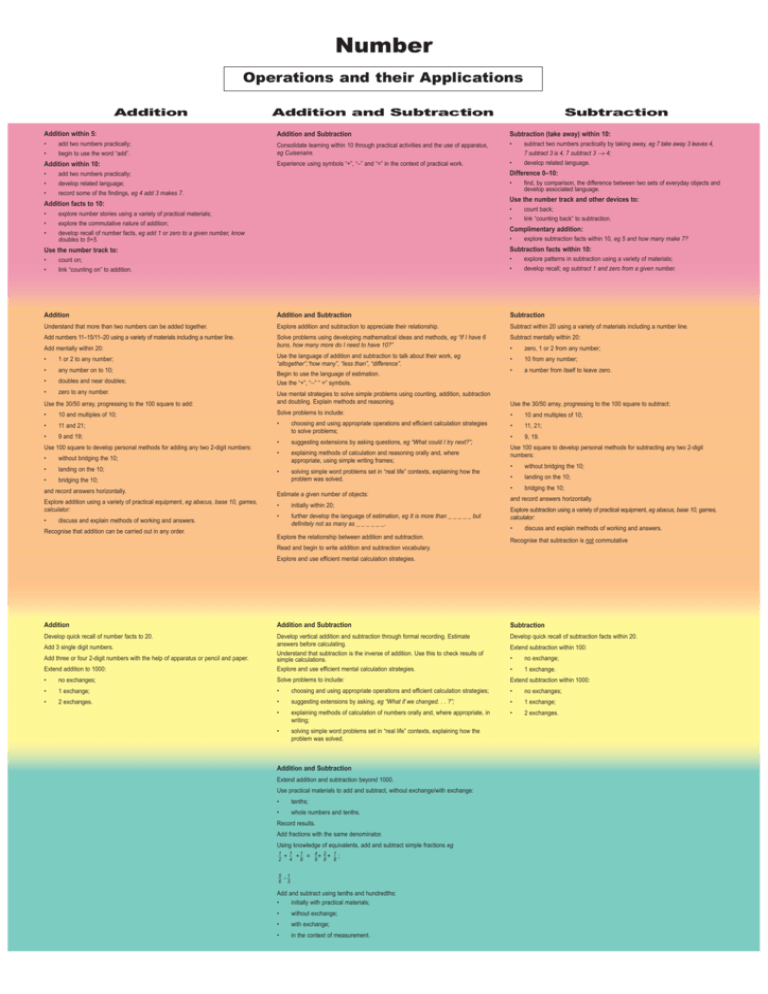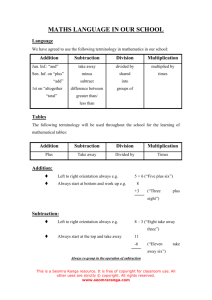Addition and Subtraction
advertisement

Number Operations and their Applications Addition Subtraction Addition and Subtraction Addition within 5: Addition and Subtraction Subtraction (take away) within 10: • add two numbers practically; • • begin to use the word “add”. Consolidate learning within 10 through practical activities and the use of apparatus, eg Cuisenaire. Experience using symbols “+”, “–” and “=” in the context of practical work. • Addition within 10: subtract two numbers practically by taking away, eg 7 take away 3 leaves 4, 7 subtract 3 is 4, 7 subtract 3 → 4; develop related language. • add two numbers practically; Difference 0–10: • develop related language; • • record some of the findings, eg 4 add 3 makes 7. Use the number track and other devices to: Addition facts to 10: • explore number stories using a variety of practical materials; • explore the commutative nature of addition; • develop recall of number facts, eg add 1 or zero to a given number, know doubles to 5+5. find, by comparison, the difference between two sets of everyday objects and develop associated language. • • count back; link “counting back” to subtraction. Complimentary addition: • explore subtraction facts within 10, eg 5 and how many make 7? Use the number track to: Subtraction facts within 10: • count on; • link “counting on” to addition. • • explore patterns in subtraction using a variety of materials; develop recall; eg subtract 1 and zero from a given number. Addition Addition and Subtraction Subtraction Understand that more than two numbers can be added together. Explore addition and subtraction to appreciate their relationship. Subtract within 20 using a variety of materials including a number line. Add numbers 11–15/11–20 using a variety of materials including a number line. Solve problems using developing mathematical ideas and methods, eg “If I have 6 buns, how many more do I need to have 10?” Subtract mentally within 20: Add mentally within 20: • 1 or 2 to any number; • any number on to 10; • doubles and near doubles; • zero to any number. Use the language of addition and subtraction to talk about their work, eg “altogether”,“how many”, “less than”, “difference”. Begin to use the language of estimation. Use the “+”, “−” “ =” symbols. • zero, 1 or 2 from any number; • 10 from any number; • a number from itself to leave zero. Use the 30/50 array, progressing to the 100 square to add: Use mental strategies to solve simple problems using counting, addition, subtraction and doubling. Explain methods and reasoning. Use the 30/50 array, progressing to the 100 square to subtract: • 10 and multiples of 10; Solve problems to include: • 10 and multiples of 10; • 11 and 21; • • 11, 21; • 9 and 19; choosing and using appropriate operations and efficient calculation strategies to solve problems; • suggesting extensions by asking questions, eg “What could I try next?”; • 9, 19. • explaining methods of calculation and reasoning orally and, where appropriate, using simple writing frames; • solving simple word problems set in “real life” contexts, explaining how the problem was solved. Use 100 square to develop personal methods for adding any two 2-digit numbers: • without bridging the 10; • landing on the 10; • bridging the 10; and record answers horizontally. Explore addition using a variety of practical equipment, eg abacus, base 10, games, calculator: • discuss and explain methods of working and answers. Recognise that addition can be carried out in any order. Estimate a given number of objects: • initially within 20; • further develop the language of estimation, eg It is more than _ _ _ _ _ but definitely not as many as _ _ _ _ _ _. Explore the relationship between addition and subtraction. Use 100 square to develop personal methods for subtracting any two 2-digit numbers: • without bridging the 10; • landing on the 10; • bridging the 10; and record answers horizontally. Explore subtraction using a variety of practical equipment, eg abacus, base 10, games, calculator: • discuss and explain methods of working and answers. Recognise that subtraction is not commutative Read and begin to write addition and subtraction vocabulary. Explore and use efficient mental calculation strategies. Addition Addition and Subtraction Subtraction Develop quick recall of number facts to 20. Develop quick recall of subtraction facts within 20. Extend addition to 1000: Develop vertical addition and subtraction through formal recording. Estimate answers before calculating. Understand that subtraction is the inverse of addition. Use this to check results of simple calculations. Explore and use efficient mental calculation strategies. • no exchanges; Solve problems to include: Extend subtraction within 1000: • 1 exchange; • choosing and using appropriate operations and efficient calculation strategies; • no exchanges; • 2 exchanges. • suggesting extensions by asking, eg “What if we changed. . . ?”; • 1 exchange; • explaining methods of calculation of numbers orally and, where appropriate, in writing; • 2 exchanges. • solving simple word problems set in “real life” contexts, explaining how the problem was solved. Add 3 single digit numbers. Add three or four 2-digit numbers with the help of apparatus or pencil and paper. Addition and Subtraction Extend addition and subtraction beyond 1000. Use practical materials to add and subtract, without exchange/with exchange: • tenths; • whole numbers and tenths. Record results. Add fractions with the same denominator. Using knowledge of equivalents, add and subtract simple fractions eg 1 2 + 14 + 18 = 48 + 28 + 18 ; 5 6 -1 3 Add and subtract using tenths and hundredths: • initially with practical materials; • without exchange; • with exchange; • in the context of measurement. Extend subtraction within 100: • no exchange; • 1 exchange.






